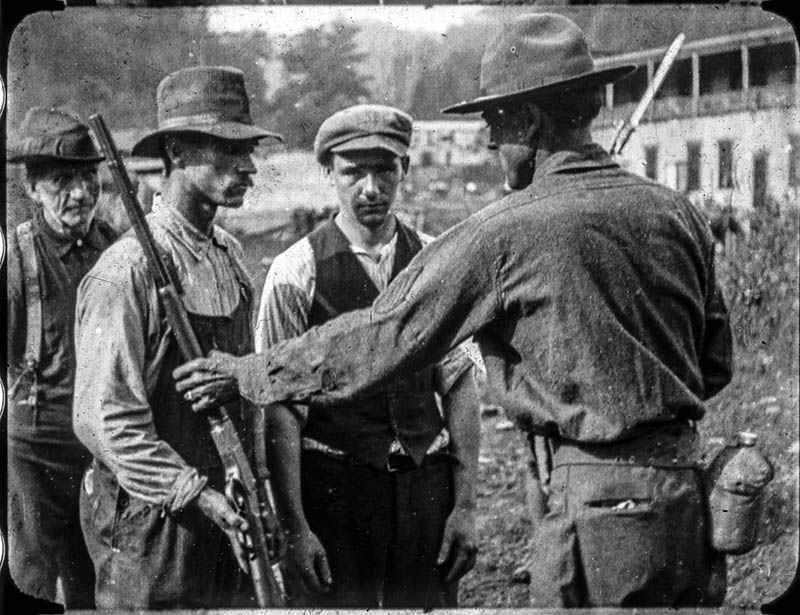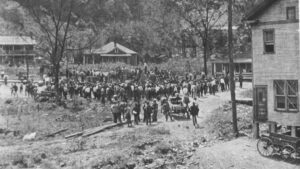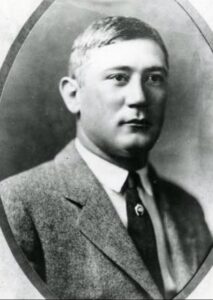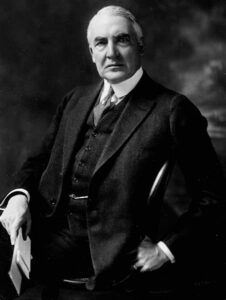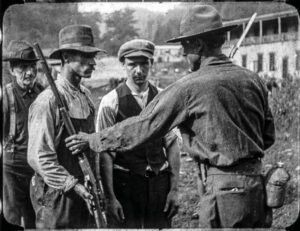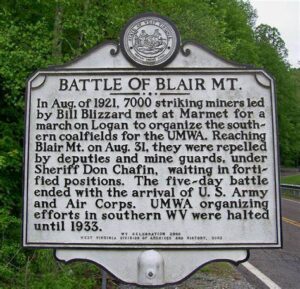The Reaction to the Assassinations
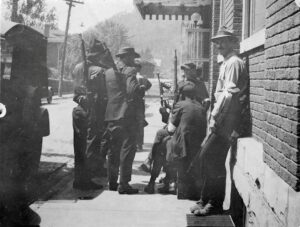
Miners were outraged by the assassinations of Hatfield and Chambers. They understood that the assassins would not face punishment for the crimes. The miners then organized and armed themselves across the state of West Virginia. Tensions were high and the march toward Blair Mountain would soon begin. The Appalachian Mountains would once again be at war.
One source states that the Little Coal River was the first to organize and began patrolling and guarding the area. Sheriff Don Chafin sent troopers to stop the activity. However, the troopers were captured, disarmed, and sent fleeing from the area.
August 7, 1921
Frank Keeney and Fred Mooney were leaders of the United Mine Workers (UMW) union District 17. They called for a rally in Charleston, West Virginia. There they met with Governor Ephraim Morgan and presented him with the Union’s demands. The Governor refused these demands.
Within a few days, thousands of union supporters came to the outskirts of Marmet, which is near the state capital of Charleston. According to one source, between 5,000 to 20,000 miners gathered in Lens Creek. Both sides were intent to march to Matewan. Some were already armed, others gathered arms and ammunition on the way with the help of the town that were along the path to Matewan.
August 24, 1921
Lead by Frank Keeney and Fred Mooney, on August 24, 1921, they marched upon Mingo County to confront the coal companies, to organize the county, free the imprisoned union men there, as well, and to end martial law. Many of the marchers were World War I veterans.
Red Neck Army
To distinguish themselves on the battlefield, the miners tied red bandanas around their necks. This was so that they could be seen by their fellow miners and not be shot accidentally through the wooded area. Many historians believe that this is where the term “redneck” comes from to this day.
Logan’s Defenders
Logan County became the battleground as anti-union Logan County Sheriff Don Chafin had gathered men to stop the miners from reaching Matewan.
In that number were between 2,000 and 3,000 Baldwin-Felts agents, county police, state militiamen, deputies, citizen militiamen, and state police. The men had constructed machine gun nests and trenches around the base of Blair Mountain and prepared themselves for the arrival of the marching miners.
Last Minute Ceasefire
At the last minute, Keeney and Mooney tried to stop the march. They had met with the War Department’s General Harry Bandholtz. The General had warned the men that any violence would be blamed upon the union. A ceasefire was proposed but collapsed when two miners died in a skirmish with Sheriff Don Chafin and his men.
August 28, 1921
The 5,000 to 20,000 union miners had reached the border of Logan County and had begun trading gunfire with the company supporters. Both sides met at Blair Mountain, West Virginia. The fight began between the miners and the blockade. Sheriff Chafin had fewer men but was better armed with rented aircraft, machine guns, and bombs.
August 30, 1921
President Warren G. Harding threatened to enact martial law in West Virginia in all the counties affected by the conflict. Those Counties were Boone, Mingo, Logan, and Kanawha. He gave the ultimatum that the fighting had to cease by noon on September the first of that year.
Also standing at the read were troops from the 26th and 19th Infantry divisions at Camp Dix, New Jersey and Camp Sherman, Ohio. The troops could be sent by train to West Virginia when needed.
August 31, 1921
The heavy fighting started when a group of 75 miners led by Reverend Wilburn came across a group of Logan’s Defenders on a ridge. Each side asked the other for the password when the wrong one was given, the fighting started. Three deputies and one miner were killed in the skirmish.
Later that day, the main group of miners gave a two-pronged attack against the trenches and breastworks of Logan’s Defenders. Using machine gun fire from higher ground, the defenders were able to push back the Redneck Army despite their overwhelming numbers.
September 1, 1921
The Redneck Army had looted the Company Store, got a Gatling gun, and assaulted a spot called Craddock Fork. Fighting went on for three hours as the Defenders were using their machine gun. When the machine gun jammed, the miners made a huge surge forward and broke the defensive line, only to be pushed back by a second machine gun.
Chafin had chartered three private biplanes and had them equipped with homemade bombs, pipe bombs (loaded with nuts and bolts), and tear gas. This effort failed to inflict any casualties even though they were dropped over two of the Redneck Army’s strongholds.
A squadron of US Army reconnaissance planes began patrolling the skies on this day and the next day. And troops from the US Army and Army National Guard led by William Eubanks, a McDowell County native, arrived and started unloading equipment.
September 2, 1921
Ignoring the threat, the union leaders continued to encourage the miners to continue fighting. Two thousand, five hundred federal troops arrived with machine guns and armed military aircraft. They also brought gas bombs and explosives that were used in World War I. Seeing that they were now fighting a losing battle, the miners and the unions backed off and disarmed themselves. The fighting, however, continued in some areas until September 4th. Around 1,000 miners surrendered to the army while the rest went home.
The Aftermath
While the numbers of the dead have never been confirmed, there are estimates of 20 to 100 killed on the miners’ side and 30 killed on the Chafin side of the conflict. There were hundreds more wounded or injured. It is estimated that one million rounds of ammunition were fired during the days of the battle.
Many faced the charges of murder, conspiracy to commit murder, accessory to murder, insurrection, and treason against the state of West Virginia for their participation in the march from Lens Creek to Logan County and the ensuing Battle of Blair Mountain.
These charges were levied against 550 to close to 1000 miners and labor activists including Keeney and Mooney. After all the legal battles most were acquitted while others spent years in prison. However, the legal battles had taken a huge toll on the bank accounts of the UMWA. The union’s membership also dropped by half in the years between 1921-1924. This membership further dropped to just a couple of hundred miners by 1930.
However, this battle did lead to some improvements in working conditions at the mines. The battles raised awareness of the harsh working conditions of the coal mines. The unions also had a change in tactics in political battles. This major change helped the unions get the law on the labor side.
We hope that you have enjoyed learning about the Matewan Massacre and the Battle of Blair Mountain. We thank you for supporting our page.
Source Information
United Mine Workers
https://en.wikipedia.org/wiki/United_Mine_Workers
West Virginia coal wars
https://en.wikipedia.org/wiki/West_Virginia_coal_wars
The Coal Mining Massacre America Forgot
The mountains of southern West Virginia are riddled with coal—and bullets
https://www.smithsonianmag.com/history/forgotten-matewan-massacre-was-epicenter-20th-century-mine-wars-180963026/
The Battle of Blair Mountain
https://www.nps.gov/articles/000/the-battle-of-blair-mountain.htm
Coal Wars
https://en.wikipedia.org/wiki/Coal_Wars
Lengthiest murder trial in WV history begins
https://www.appalachianhistory.net/2019/01/lengthiest-murder-trial-in-wv-history.html
January 26, 1921: Sid Hatfield’s murder trial
www.wvculture.org/history/timetrl/ttjan.html#0128
“Still Fighting the Battle of Blair Mountain,” by C. Belmont Keeney
https://cbelmontkeeney.blogspot.com/2009/07/original-redneck-explanation.html
The Matewan Massacre: beyond the myth
http://www.matewanmassacre.com/
The Massacre/Blair Mountain Webpages
https://www.history.com/news/7-things-you-didnt-know-about-the-hatfields-and-mccoys
‘Matewan Massacre’ a century ago embodied miners’ struggles
https://abcnews.go.com/US/wireStory/matewan-massacre-century-ago-embodied-miners-struggles-70742420
The Coal Mining Massacre America Forgot
The mountains of southern West Virginia are riddled with coal—and bullets
https://www.smithsonianmag.com/history/forgotten-matewan-massacre-was-epicenter-20th-century-mine-wars-180963026/
Matewan Massacre
https://www.nps.gov/articles/000/matewan-massacre.htm
West Virginia coal wars
https://en.wikipedia.org/wiki/West_Virginia_coal_wars
The Battle of Blair Mountain
https://www.history.com/news/americas-largest-labor-uprising-the-battle-of-blair-mountain
Matewan Massacre Beyond the Myth
http://www.matewanmassacre.com/
The Matewan Massacre and The Three Day Battle
https://coalminewars.net/Matewan_Massacre.html
Battle of Blair Mountain
https://en.wikipedia.org/wiki/Battle_of_Blair_Mountain
The Battle of Blair Mountain
https://www.nps.gov/articles/000/the-battle-of-blair-mountain.htm
Coal Wars
https://en.wikipedia.org/wiki/Coal_Wars
The Trial Websites
Lengthiest murder trial in WV history begins
https://www.appalachianhistory.net/2019/01/lengthiest-murder-trial-in-wv-history.html
January 26, 1921: Sid Hatfield’s murder trial
www.wvculture.org/history/timetrl/ttjan.html#0128
“Still Fighting the Battle of Blair Mountain,” by C. Belmont Keeney
https://cbelmontkeeney.blogspot.com/2009/07/original-redneck-explanation.html
The Matewan Massacre: beyond the myth
http://www.matewanmassacre.com/
Copyright and Other Information
All photos are in the public domain unless otherwise noted. This includes photos dated before 1923. All other photos are used with permission or under the education fair use statute of the US copyright law.
Copyright 2022 Kentucky Tennessee Living
kytnliving.com/copyright-2/
Social Media Pages
For more about us, you can visit our Facebook page:
https://www.facebook.com/kytnliving
Our Twitter page:
https://www.twitter.com/KYTNLiving
Our YouTube Channel:
https://www.youtube.com/kytnliving
When we forget our past and who we are as a people, then we become who “they” say we are. ~~ David Sergent
I have attended the University of Kentucky. I have an Associates Degree from Hazard Community College and Technical School. I have also attended the University of Pikeville. I have taken several classes in Journalism as well as in the Appalachian History, Literature, and Sociology during my time at those schools.
I was born in Florida and grew up in Burdine, Kentucky. I have been married to David W. Sergent since May 4, 2013. I have two children and four grandchildren from a previous marriage. I currently live in Tennessee but my hope is to one day come back home to live in the beautiful mountains once more.


